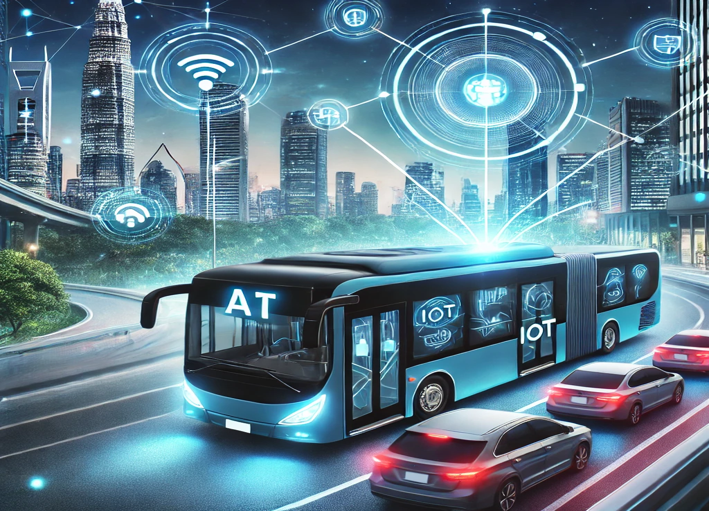
Reduce Unexpected Delays & Traffic Issues with Bus Tracking System
Rapid population growth is noticed in major cities of the world. According to a study conducted by the World Bank, more than half of the world’s population lives in urban areas. It indicates that urban areas will account for 60% of the global population by 2023. Cities are growing not only in numbers but also in population and land area. Growth of urban population is creating unexpected delays in bus transportation. In this blog, we’ll discuss how a bus tracking system can address unexpected delays and traffic issues.

Before delving into the details, let’s try to figure out the reasons behind unexpected delays in bus transportation.
Reasons behind Unexpected Delays in Bus Transportation
Many reasons work behind unexpected delays and traffic issues in bus transportation. Here, we’ve listed the major ones:
1. Common Traffic-Related Issues
Common traffic related issues include road congestion due to peak hours and urbanization and detours caused by accidents and road constructions.
2. Operational Inefficiencies
Operational inefficiencies are another reason behind unexpected delays. Poor route planning and scheduling, unplanned stops and extended waiting times, inefficient communication between drivers and fleet managers can trigger operational inefficiencies.

3. Environmental and External Factors
Environmental adversities like rain, snow, and fog can cause unexpected delays. Moreover, external factors like unexpected breakdowns and maintenance issues can also cause unexpected delays and traffic issues.
Impact of Delays on Stakeholders
Unexpected delays cause passenger frustration and reduce reliability. On the other hand, it increases operational costs for transit companies and decreases efficiency in logistics and corporate transportation.
What is a Bus Tracking System?
A bus tracking system is a tech solution that enables real-time monitoring and management of buses in transit. It includes GPS tracking, route optimization, real-time ETAs, and fleet management features to enhance operational efficiency and safety.
Key Components of a Bus GPS Tracking System
GPS Tracking
GPS tracking provides location updates of buses, allowing passengers and operators to monitor movements.

Real-time ETA & Notifications
Passengers receive accurate estimated arrival times and alerts for delays, helping them plan their trips better.
Route Optimization
With route optimization, a real-time bus tracking system suggests the most efficient routes, reducing delays and fuel consumption.
Geofencing Alerts
Bus service providers can notify the customers when a bus enters or exits a designated area (bus depots/zones)
Driver Monitoring
Bus operators can track driving behavior, speed, and adherence to schedules for safety and compliance.
Passenger Information System
This system displays real-time bus locations and arrival times via mobile apps, websites, or digital signage.
Mobile App & Web Dashboard
Operators can monitor fleet performance, while passengers can track buses and plan their journeys.
Integration with Ticketing & Payments
Some systems integrate with digital payment solutions for seamless ticket purchases.

How does a Bus Tracker System Help Reduce Delays?
A bus GPS tracker system plays a crucial role in reducing delays by providing real-time tracking, optimizing routes, and improving communication between drivers, operators, and passengers.
Traffic Management
One of the primary reasons for bus delays is unpredictable traffic conditions. A real-time bus tracking system, equipped with GPS and AI-driven predictive analytics, helps identify congestion ahead of time. This allows operators to reroute buses dynamically, ensuring they take the fastest possible path and avoid unnecessary slowdowns.
Fleet Management
Better fleet management is another significant factor in reducing delays. With live tracking, transit operators can monitor bus locations, speed, and estimated arrival times. If a bus is running behind schedule, adjustments can be made by dispatching backup vehicles, rescheduling trips, or modifying stop frequencies.

Estimated Arrival Time
For passengers, real-time bus tracking means they no longer have to waste time waiting at stops. Mobile apps and digital displays show accurate ETAs (Estimated Time of Arrival), allowing riders to plan accordingly. This reduces crowding at bus stops and enhances the overall efficiency of the transportation system.
Driver Accountability
Most bus tracker systems also contribute to improved driver accountability. It has GPS for drivers to help the drivers avoid deviating from routes or make unnecessary stops when they know their movements are being tracked. Additionally, automated alerts can notify operators about speeding, long idling times, or route deviations, ensuring that buses stay on schedule.
Schedule Optimization
Lastly, historical tracking data helps transportation agencies analyze performance trends and optimize schedules based on actual demand patterns. This ensures that buses run more efficiently, reducing unnecessary delays in the long run.
By leveraging real-time data and smart analytics, a bus tracker system significantly enhances reliability, efficiency, and overall punctuality in public transportation.

Pick the Right Bus Tracking Solution for Your Needs
Selecting the right bus tracking solution depends on factors like fleet size, budget, and operational needs. A good system should offer real-time GPS tracking, allowing fleet managers and passengers to monitor bus locations and estimated arrival times accurately.
Look for a solution that includes route optimization, helping reduce delays by adjusting to traffic conditions. Features like driver behavior monitoring and automated alerts can improve efficiency and safety. If you need passenger engagement, choose a system with a mobile app and push notifications for real-time updates.
Integration is key—ensure the solution can seamlessly connect with existing dispatch systems, payment gateways, or school management platforms if required. Also, prioritize a cloud-based system for remote access and scalability.
By evaluating these factors, you can find a cost-effective and feature-rich bus tracking system that enhances reliability and operational efficiency.





